Where Can I Watch Xmen the Animated Series
Where Can I Watch Xmen the Animated Series
TV Shows
Published
Oct 23, 2022
The Making of 'X-Men: The Animated Series'
We interview the creators of the 90's hitting drawing. Watch 'X-Men: The Animated Series' on Disney+ today.
This interview has been edited and condensed for clarity.
Near thirty years afterwards its debut, fans of X-Men: The Animated Series will get an inside await at what information technology took to develop, write, and draw one of the most honey series of its decade. On sale now from Abrams Books, 10-Men: The Art and Making of The Animated Series is packed with nearly 1,500 never-before-seen concept sketches, storyboards, models, layouts, and celluloids, an art-based history on the show that made the Ten-Men a household name.
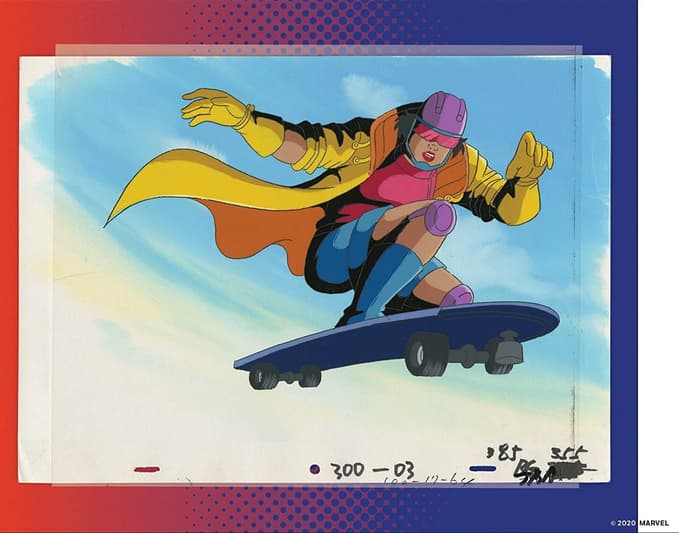
In Oct 1992, a worldwide audience was introduced to X-Men: The Animated Series and its cadre cast—a squad and found family bonded for life by the X-cistron that gives them super-powers but leaves them on the outs of society in a globe that fears their existence.
A mix of comic adaptations and original stories, 10-Men: The Animated Series stands as one of the almost successful Super Hero cartoons of all fourth dimension. And, for many fans, it was their first and well-nigh definitive take on the Children of the Cantlet.
"The ratings we got told u.s. that there were some Saturdays that over one-half of the televisions in the U.S. were watching our show," says series showrunner Eric Lewald. "And that's only such a weird, huge thing. It'southward similar, Mon morning, of grade that'southward what the kids are talking about."
Over the course of its 76-episode run, X-Men: The Animated Series had tight demands on deadline, direction, and maintaining a abiding output of animations traveling domestically and overseas. Series manager and producer Larry Houston remembered how enervating the task could be. "No computers. There were no computers and so. I brought in my collection of Ten-Men comic books to work. And when I went to manus out stories to the artists, I'd put them on the Xerox machine, copy the pages I thought were pertinent."
"Just realizing how many tens of thousands of art elements that were involved in getting a show done," recalls Lewald. "There'd be half a 2nd of screen time. And that might be eight or nine layers of paint, backgrounds, part of this graphic symbol, office of this other character."
We spoke with serial creators Larry Houston, Eric Lewald, and Julia Lewald, about the show'southward origin, favorite episodes, and where they stand on Cyclops and Wolverine.
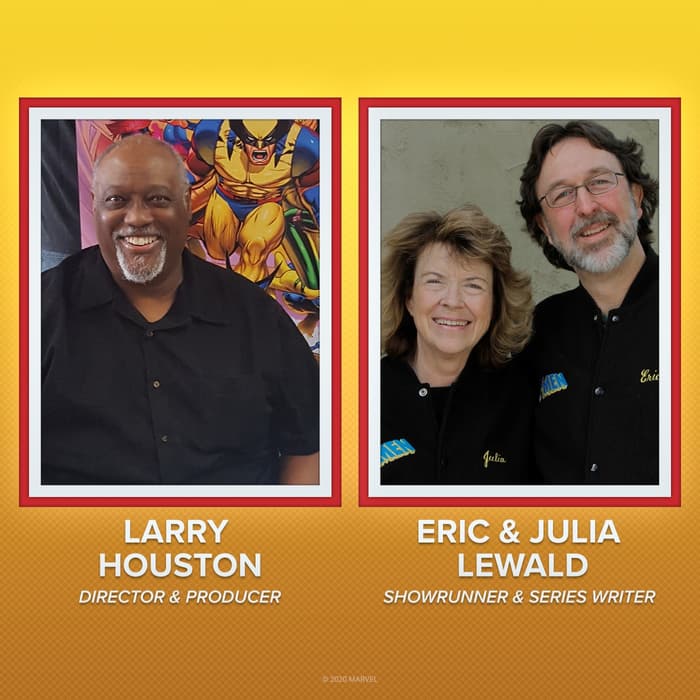
We'll first at the get-go. Larry, you came into the X-Men fold start, working on cartoons as a director and storyboard artist.
LARRY: Yeah, that's correct. I started working at Marvel Productions with Stan Lee back in '81. And I'd been a fan of the X-Men for a long time. And it was myself, [X-Men: The Animated Series co-director] Will Meugniot, and [pilot producer] Rick Hoberg. We were all three fanboys. And it got to a betoken where we had [executive producer] Margaret Loesch backside the project. And she— I'll say, she found some money in the budget to do a pilot called Pryde of the X-Men.
And and so we got a chance to at least try and show the network. Nosotros did our best to throw out the kitchen sink. But we had to brand compromises, unfortunately.
The people who were banking [Pryde of the X-Men]— Crocodile Dundee was pop at the fourth dimension. Then one of the executives asked united states, "Hey, what most making Wolverine Australian?" And we were going, "Oh, God. No." Just we figured, "OK." Lesson learned.
JULIA: But because of Larry…!
ERIC: It was valuable what Larry and Volition had done. Other people had ideas about changing [The Blithe Series] before information technology came out, making it younger, or sillier, or whatever. And there were times when we but had to put our foot down and say, "No, we're not going to put merchandise in the middle of our X-Men bear witness."
And then in February of 1992—you got your shot. X-Men: The Blithe Serial was greenlit.
ERIC: Margaret [Loesch] had wanted to do the show for ten years. Nobody in Hollywood believed the X-Men could exist popular. She'd pitch it and pitch information technology. They said, "No, this is too weird. This is too inside-comic-bookie." So Margaret could never get it sold. When she got prepare to practise it, she picked the people that she idea would exist the strongest, and she immediately went to Larry and Will. And then, I got chosen after.
I went into that first coming together in February with, y'all know, thirty people. And I didn't know a damn thing nigh the X-Men. I only had to smile and nod my head and say—
LARRY: "Certain, yeah!"
ERIC: Yeah. "What that guy Will said! That sounds good to me. Yep."
JULIA: In that location were but three networks. You may have had a few syndicated channels, depending on how big the city was that you lived in. Only you couldn't watch Television set on your cell phone, yous couldn't Google anything. And the X-Men— I'grand not beingness sacrilegious when I say this, the 10-Men were a big bargain for Marvel. Merely to the boilerplate person on the street… "Oh, the X-Men? Maybe I've heard of them."
ERIC: Yeah, Margaret Loesch warned us when we were writing stories. She said that you can have 85% to 90% of your audience on Sat morning not knowing who these people are. Brand certain that you're really clear about who everybody is, what their powers are, what the relationships are.
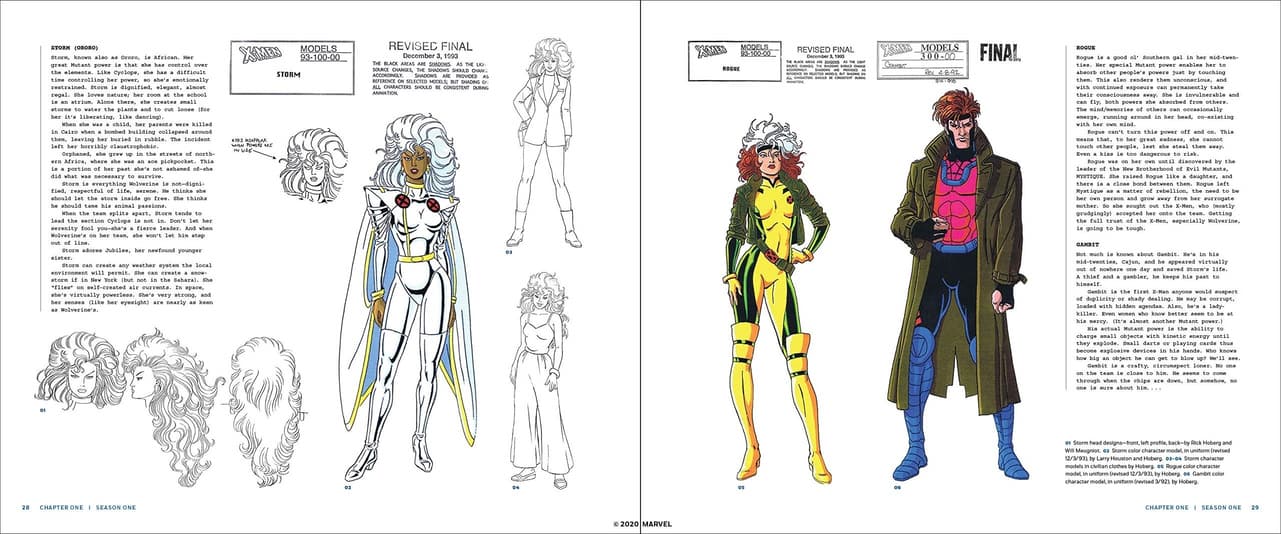
LARRY: Without [Margaret], we wouldn't have gotten anything. I mean, Margaret was the forcefulness behind Spider-Human being, Power Rangers, The Tick. She put all those shows out there—
ERIC: Even and then, believe it or not, she had to put her job on the line. Her boss said, "Look, I don't get this X-Men thing. It'southward so dark. It's adults. It'southward grim. I don't think kids are going to watch this. But y'all seem to really believe in this." And she said, "I admittedly believe in this."
He said, "To the point where if this doesn't work the get-go season, you're washed? I burn you?" She said, "Admittedly."
LARRY: She never told us that. She never told us that until way subsequently.
JULIA: Yep, she protected everybody. She took all the battles on herself.
And so, Eric, Julia, you're at present at the helm as showrunner and series writers. What's that commencement initial step?
ERIC: Well, for me, having to be in charge of the scripts and the stories, I immediately called Larry. And then, [serial writer] Mark Edens and I laid out the first 26 episodes…
JULIA: Knowing that at that place would but be 13 for sure.
ERIC: Simply Marking was equally ignorant to the X-Men as I was. We were just really big into heroic storytelling.
JULIA: Larry, the copy of the compendium y'all sent Eric… What was that based off of?
LARRY: The [Official Handbook of the Curiosity Universe,] yes.
JULIA: And when I say "copy," I mean you sent Eric the photocopies of this Marvel Universe book. We didn't know who these [characters] were.
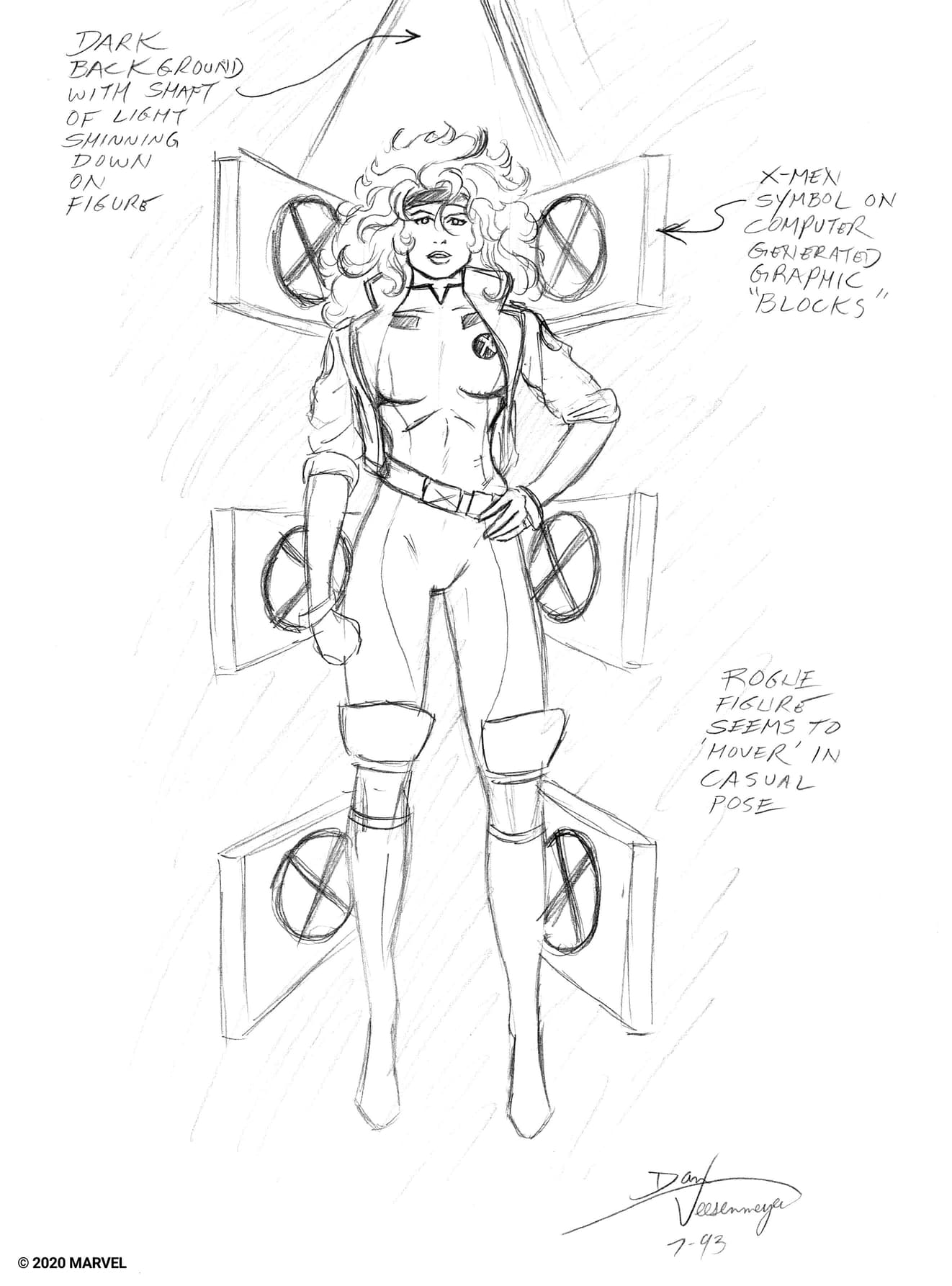
ERIC: Looking back on information technology… I was just very excited. But not beingness a fan, I didn't have an agenda like, "Oh, my God. I've got 38 different characters, and I've got to get them all into each episode!"
[Marvel Comics Editor] Bob Harras— give thanks goodness he was our advisor. He said, "Wait, at that place's been 25 years of X-Men comics. There have been all these mixes and matches… He said to Margaret, "You lot guys take information technology in the direction you desire to, as long as y'all stay with the spirit of the characters and don't get exterior the world nosotros're dealing with."
How did you go about developing your core cast and so? I of the things that was aspirational was seeing a team that was near half women.
ERIC: All Julia'due south doing.
JULIA: No. No, it was not. I wish it was.
ERIC: No, it was impaired luck that it was gender-counterbalanced. Jubilee and Gambit were newer, Marvel wanted to make sure to have them. And manifestly, Professor X. And Jean [Greyness] and [Cyclops] were the cadre people from the offset. And Wolverine's the biggest name in the history of the X-Men. And then you're already upward to about half dozen. And it happened that a couple of those [picks] were already women.
It'due south interesting. If you lot look dorsum at the quondam memos betwixt Larry and me and Curiosity, we started with a cadre cast that didn't include Beast. And Jean was secondary. And those characters grew every bit we tried to write the stories. I hateful, nosotros put Beast in jail at the beginning because he was [like] a tertiary character. Simply he asserted himself because he was so dissimilar.
JULIA: I call back too though, it speaks to— and I'll give credit to Margaret Loesch, that in the project she was passionate about, I don't recall hearing whatsoever pushback, "Oh, yous got too many girls on the squad."
ERIC: We got that in almost of the other shows we worked on. "Oh, you can have one girl."
JULIA: Correct.
ERIC: You lot could have a "Smurfette" is what nosotros chosen information technology. You get as many Smurfs every bit you want, just you but get one Smurfette.
LARRY: And one of the things [to consider] in blithe films is the audio. You lot didn't want several guys that growl with heavy, deep voices. Jubilee doesn't audio like Rogue, which doesn't sound similar Storm, which doesn't sound similar Jean Grey.
Larry, tin yous talk a flake near a director's role in animated storytelling? I imagine there'south a lot to direct before things are animated.
LARRY: A director is in charge of the testify from outset to delivery to the networks. So I start with the script. When a script comes in, I go through it and read information technology and see what it'southward all nearly. How many props? How many people are going to be in the show?
And I assign that to— it was ordinarily three act shows. And then I signed up three different artists. They accept the script. I give them notes. They go away. Come dorsum nigh 4 weeks later. And they requite me a finished storyboard. And then, I have to get through that folio past folio. It's perhaps almost 400 pages.
I had to go through the entire show and make sure they did information technology right. And if they didn't do something that was role of the show or information technology was very wearisome, I would go through with yellow Post-its and I would redraw the sequences to something I thought would be more dynamic or interesting. Or sometimes, they drew stuff wrong. So, one time that's washed, I would mitt it off to a timing director who would actually go through and time the show out. Because it's a 22-minute evidence. So you don't want to send a 25-infinitesimal prove overseas considering that's non what [the animators] are getting paid for.
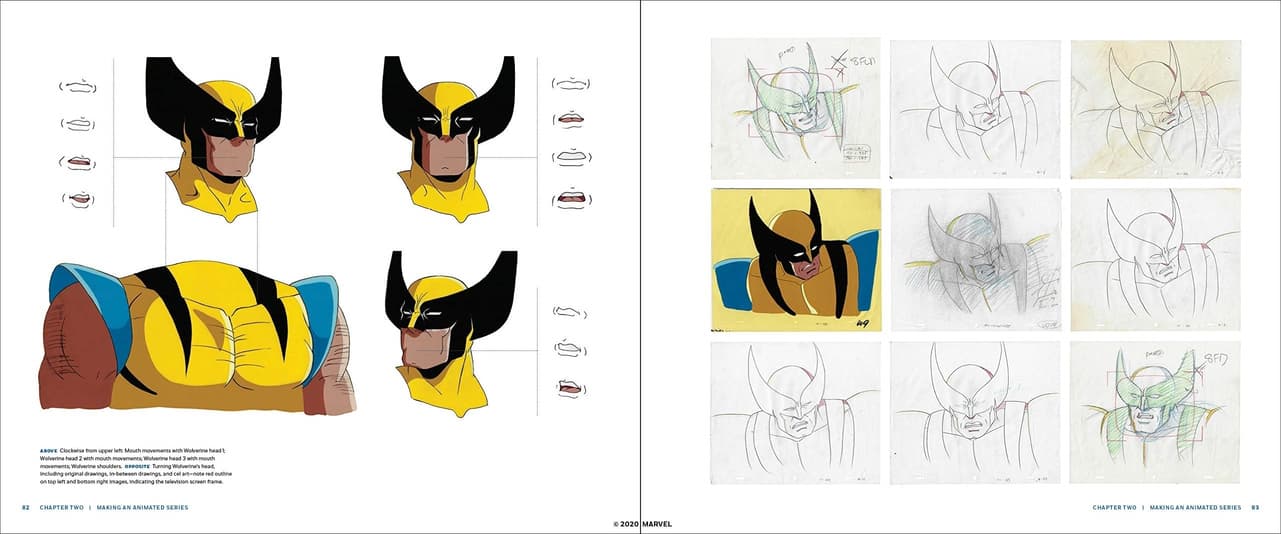
Then once the episode is animated…
LARRY: So, we would get the show back from overseas. There would be good stuff, bad stuff. You'd have to practice a retake list. "OK, this is done correct. This is washed incorrect." You know, sometimes a oral fissure would be over hither somewhere talking… effect shots and activity errors.
It's a dual job. I'd be sending shows overseas and getting shows back. And and so, you had to keep all this stuff in your caput at the same time, aircraft shows out, shows coming in, calling retakes, fixing the boards…
ERIC: People don't realize how much overlap there is in an animated bear witness. In a alive action show— much easier to write.
When you spoke near keeping each script shut to time… I loved that fact from Previously on Ten-Men: The Making of an Animated Series [Eric Lewald's interviews with cast and coiffure] nigh how "X-Communicators" were used in after seasons to tighten action even more.
ERIC: When Mark [Edens] and I laid out the first stories, we just assumed that the sci-fi Star Trek convention of communicators existed. When there are eight or ten atomic number 82 characters, information technology would be anarchy for them to try to deal with big activity sequences if they had to be inside shouting distance.
LARRY: Because I approached the bear witness with about twelve years of existence a director beforehand, I knew all the shortcuts of how to make the testify fit. And except for some exceptions in Flavour One, you would rarely see the X-Men walk across the screen. It's like you lot'll see the group say, "OK, permit's go." And and so you'll see the frazzle of the jet.

You lot know, information technology's going back to the shows I grew upward with, which was Jonny Quest. Jonny Quest didn't take a lot of animation. But when you saw the shot, y'all could look at it for two days because it was then well drawn and composed. That's one of the things I was trying to bring to X-Men.
Volition [Meugniot] and I were both being introduced to anime likewise—information technology was but coming over in the '80s. And nosotros would go these large LaserDiscs and nosotros would— the director was Miyazaki. And we were at Filmation [Studios]. We would just put the disc on. Watch his shows and only clarify it.
One of the things that kept coming to the surface while reading "Previously On" was how X-Men was allowed to embrace "serious" adult themes, similar the "Nightcrawler" episode, or even Morph's death. Both of those received pushback from network censors, correct?
JULIA: First off, allow's give a shout out to the woman who deserves credit. A adult female named Avery Coburn who was the Broadcast Standards and Practices person at Fox Kids at that time. And, proficient Lord, nosotros worked on shows where that kind of gatekeeping can just suck the energy out of a project.
Avery was someone who was onboard with X-Men from the kickoff. And if she hadn't been, information technology wouldn't be the show it was.
ERIC: Considering [censors] take absolute authority. I mean, they only say, "No, we tin't even talk nigh someone dying," much less testify someone dying.
JULIA: Religion, are you crazy?
ERIC: Yeah, we tin't refer to faith. Nosotros tin't have sexual banter among the X-Men because, well, they're all living together in the house, and none of them are married!
We had things on other shows where you couldn't be aroused at each other.
JULIA: Because they're on the same squad—
ERIC: Aye, yeah. You know, executives asked this: "Why do yous keep writing characters who are arguing and so much?"
LARRY: They're a family!
ERIC: Practice I take some conflict and drama, or exercise I not? Or practise you desire them all to be the 6 same people smiling at each other?
That gut dial between Wolverine and Cyclops was a particularly big bargain as well, right? Later on Morph's decease in "Night of the Sentinels, Part Two"?
ERIC: That was about a two week discussion. That was almost every bit long as the death discussion. "Can nosotros let [Wolverine] punch [Cyclops]?" Both of them came downwards to Avery agreement that it was all about grief and information technology wasn't complimentary.
LARRY: Right. And we only did information technology one time. But it made the indicate of setting us apart from Super Friends and other shows out there.
JULIA: And, I'd also like to say, regarding [the "Nightcrawler"] episode—you know, so many folks come and when we go a take chances to actually talk, specific episodes mean so much to them. I'yard so impressed with "Nightcrawler" because it doesn't proselytize. It doesn't say you lot take to be Christian, you need to convert.
It'southward a respectful exploration nigh religion and what information technology means to one person and what information technology tin or cannot mean to someone else. I don't know if you could get abroad with telling that story today.
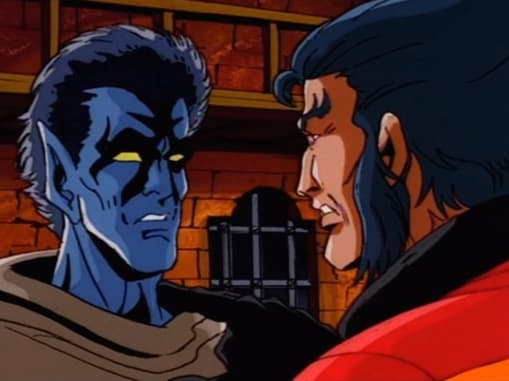
ERIC: There's a line that Gambit has at the very stop, simply before Rogue sees Wolverine in the church. He's basically saying, "Oh, at that place is no God. Life'due south just a crapshoot. Just a game of cards."
And on our first line of notes— it was, "No, yous've got to cut this out. Nosotros tin can't say something this farthermost." And that'due south part of the remainder with censors. If [Avery] gave me thirty notes on that, I could question a dozen of them and say, "Well, tin can we do this? Or, "Nosotros really need this i thing here."
JULIA: I have ane Avery Coburn story that I've shared before. But we found an erstwhile memo. It was [an episode] in the Savage Land. And there'south volcanoes and stuff— bad things are happening.
Simply we see a dinosaur autumn in a volcano. And a memo from Avery to [executive] Sidney Iwanter is, "OK, y'all can have this activity, you tin have that activeness. Only I'thousand going to demand to meet that dinosaur climb out of the volcano so nosotros know he'southward OK."
LARRY: Julia, this reminded me—when you went to [Fox Studios]. In the start season, we didn't know how kids reacted to the show.
JULIA: We would get the ratings, which came out in one case a week. And we all read that X-Men was really doing well. And a [Fox executive] said, "Well, come with me. I'll show you." [We get] out in the hallway, and there were those big milky cartons that hold mail that the USPS uses, there is a stack of those…
And it's stacked up to the ceiling. And they're stacked all effectually the hall and all the way back. And she said, "Everything in here, these are all for X-Men. These are all kids who love the X-Men."
LARRY: That's how we found out.
Why do you think it resonated so well with kids?
ERIC: Larry has a theory on it.
LARRY: Part of information technology is that the show was written so that a younger audience would be very entertained by the laser beams and the explosions. And it was a lot of eye candy.
But these guys wrote a lot of subtext into this then that when people got older and they saw the reruns, they started picking upwardly on what everybody had prepare up: the adult relationships, how people were being persecuted in club…
JULIA: I think too—the X-Men themselves—the turning into a mutant when you hitting puberty, and you lot maybe get a mutant, maybe you don't. I don't think there'south a child in America that tin can't relate to feeling so dissimilar, so other, so "Oh, my God, what's happened to my world?" that you tin't identify. You'll pick out your X-Men.
Who were those X-Men for all of you? Any favorites or someone you loved to write?
JULIA: I always jump in with honey Fauna, Hank McCoy. The damaged poet who was just the smartest guy in the room. It was fun writing for him considering every writer likes to think that he or she is the smartest person in the room. Here, Beast really was the smartest person in the room. So writing for him was kind of like, yeah, I can practice this. I can keep upward with Creature.
And again, dorsum in 1992, no internet. Those quotes that you came up with for him to say, nosotros had a Bartlett's book of quotations. "So he's talking about a battle assault. What quote would yous use for a battle?" Writing for Beast was a joy, very much so.
ERIC: I empathized the most with Xavier. I had twenty different people who wrote X-Men for me. And keeping all of them writing—keeping it smooth and consistent… I felt very much like Xavier dealing with eight dissimilar X-Men who were all such dissimilar people. I very much empathized with the father effigy in charge of holding the enterprise together.
Larry, who did you like to describe best?
LARRY: It would exist a tie betwixt Wolverine and Rogue. Because Rogue could pretty much dial her way out of anything. And the Wolverine would just slice and dice. Although with Wolverine, I had to be careful because if we didn't have the Sentinels, he would have zero to exercise because his ability is to eviscerate and disembowel.
Larry, I know you and Will Meugniot had fun planting Easter eggs too. As the comic volume fans behind X-Men, yous were both responsible for many series cameos.
LARRY: I used to read the comic books in the '60s. I'd be reading a Spider-Man volume, and in i panel you lot'd come across Thor go through a panel. And then at the lesser, Stan would say, "If yous desire to see where Thor'due south going, buy issue, you lot know, something." And he created a connected universe. I wanted to bring that childhood excitement to the evidence.
But what I discovered early on is that I couldn't call the characters their names when I submitted the piece of work into the system. Because I tried that with Spider-Man—they kicked it out. There's an episode called "Slave Isle," where the writers wrote, "Mutants One, Two, Iii, Four, 5." And then, I got my books. I told the artists, "OK, make this the Blob. Brand this Mystique. Make this, you know, Sunfire." I started populating with Marvel characters. But I kept the aforementioned names.
JULIA: "Mutant One—"
ERIC: We had to ask to have Captain America in. Information technology took a couple three weeks to become it canonical.
JULIA: For the "Old Soldiers" episode.
One of my favorite arcs was your "Phoenix" and"Dark Phoenix Saga." Ithink information technology was the best screen adaptation to date. How different was it to adapt then closely from the source cloth versus working off an original story?
ERIC: The few times we fabricated directly adaptations similar with "Days of Future By" or "Phoenix," we felt fans of the original [comics] would care about these stories, and then we only chose to make changes when we had to.
Much of both "Phoenix" adaptations had to do with trimming down secondary characters and focusing on a core story. In "Phoenix" that meant focusing on Xavier and Lilandra, since every bit this huge crisis was playing out, they were the best points of view for the audience. In "Dark Phoenix" we shifted the point of view more to Cyclops because the great crises were happening to the woman he loved, and it made for the about dramatic and heartfelt story.
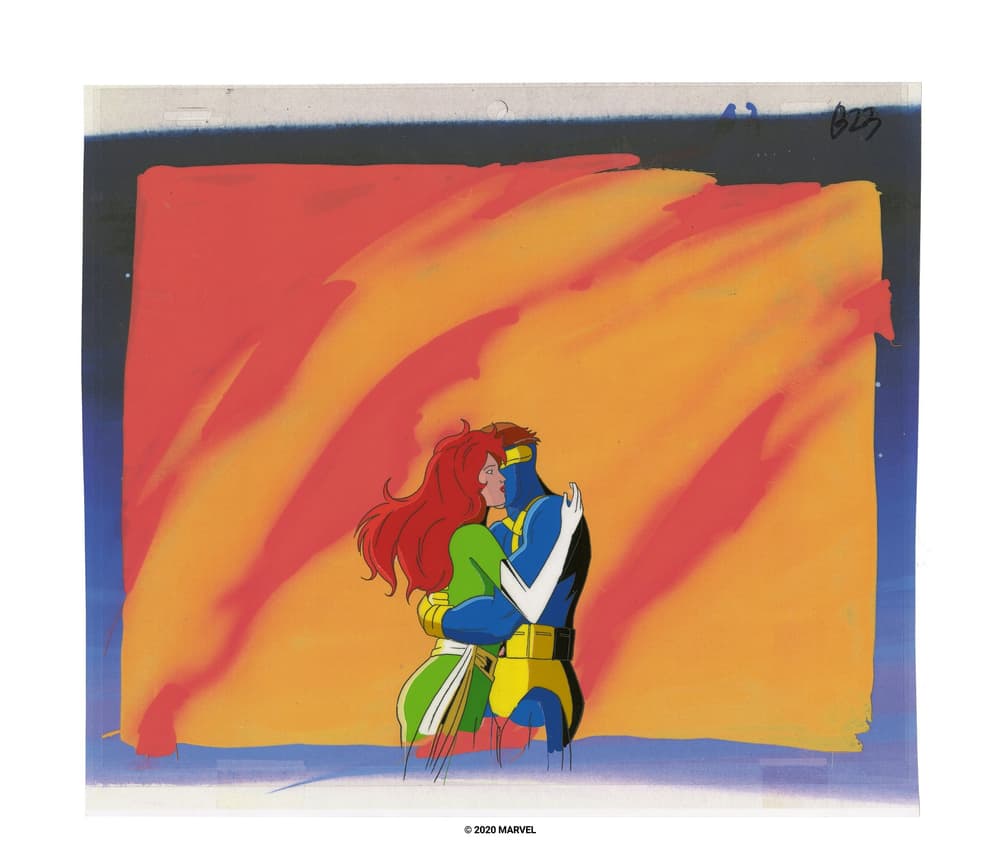
LARRY: I made sure all the off-world locales matched the comic book stories they were based upon. My fanboy memories of Marvel's alien races went back, so I knew all of them at that fourth dimension.
Equally far as staging the battles, I encouraged the storyboard artists to use every bit much of the staging from the books whenever possible. There are a few scenes in "Phoenix" that I made sure mimicked images from issue [UNCANNY X-MEN #137] "Phoenix Must Die," like when the X-Men first appear on the deck of the Shi'ar ship.
Anyone else have a favorite multi-parter?
LARRY: "Time Fugitives" would exist the one for me. The script came in. And Role Two didn't match up to Function One in terms of the activeness sequences.
And so for Part 2, I had to re-storyboard about 40 or 50 pages to match up so that it looked similar the same timeline but with new stuff happening. I added the scene of Apocalypse growing out of the edifice. And he shoots his rays, and he kills the Ten-Men. So it upped the stakes, like, "Oh, crap. How are they going to go out of this 1?"
I was having fun with information technology. Trying to be a fan and be a professional at the same time.
ERIC: [TO JULIA] I know what your favorite ii-parter is.
JULIA: I got to write "Days of Future Past, Part 1." And existence challenged to write what we were going to write for a "Sat morn child's evidence." It was like, how—but everyone—and information technology started with Margaret Loesch from the top down was like, "You do not write downwardly to kids. You write up. Pretend this is a half-60 minutes alive action drama at night and just go for it."
And I'd never been given that kind of latitude before.
ERIC: "I Human's Worth" was the one that felt rightest to me.
LARRY: Correct. Yeah.
ERIC: Information technology's like, here's a story. This is the reason the X-Men be. Considering the question was, "What would happen if Xavier were killed when he was younger?" And there would never be the X-Men. That was such a simple story. I hateful, we were ripping off people similar It'southward a Wonderful Life and The Urban center on the Edge of Forever…
JULIA: From Star Expedition.
ERIC: You know, y'all have your inspirations where you can. Only it just— when that idea came to me it was similar, OK, in four years, this is the best idea I've had for the prove. And thank God it happened that I didn't think of it a year later we were done.
JULIA: And information technology killed me go that Storm and Wolverine are in that awful future parallel universe…
LARRY: Wolverine and Storm in that story— Eric wrote [ane of] the beginning interracial kisses, interracial marriages, in blitheness. Only something else that Eric did—when he created the story One Man'south Worth, Marvel liked information technology and then much that they went ahead and it inspired the AGE OF APOCALYPSE.
I was able to have the Age OF APOCALYPSE designs and incorporate it into Eric's stories. And so you got a chance to see those characters that they designed [for the comics.]
JULIA: This is the first time I'm hearing that. That's wonderful. I did not realize that.
ERIC: We merely thought it was your original brilliance.
The serial' theme song and opening sequence though… that was Larry's brilliance?
ERIC: All Larry and Volition Meugniot's doing.
LARRY: I drew the intro. Initially, I drew mode, way more than images than we needed. Will, who was the Supervising Producer, created the first two dynamic scenes and I followed his lead and culled it all down into the intro that nosotros used. [The Art and Making of the Animated Series] has the total, unedited version I drew.
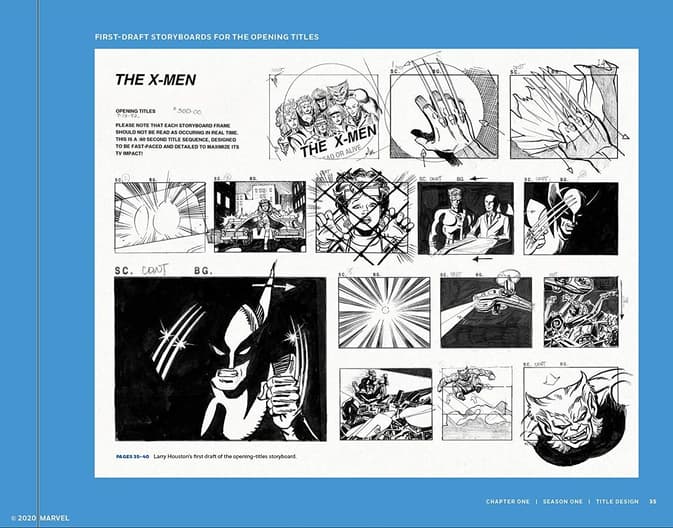
Oh, and the terminal music for the intro was probably version number twelve or thirteen. All the prior versions weren't proficient enough. Nosotros held out until we got it merely perfect.
Can we talk almost your vocalization actors for a moment? Ten-Men delivered some iconic performances.
JULIA: I love me some Hugh Jackman, only I hear Cal Dodd when I retrieve of Wolverine.
Your actors were all Canadian, right? And later an entire first round of auditions, you weren't finding anyone who was shut to a skilful fit?
ERIC: It was wrong. It was so wrong.
LARRY: They recorded the get-go evidence, and it came back to Los Angeles. And Margaret and everybody was like, "Oh, my God, this is awful." And they had to ship Sidney and myself up to Toronto to come across what the hell was wrong with the shot and correct it.
Luckily, instead of having traditional cartoon voices, they found actors who worked in the theater. So they had a meliorate range of inflections in the stories. They didn't practice traditional Scooby-Doo, or something. They actually put feelings and voices on pocket-sized words.
And one of the two that I can remember immediately was Cal Dodd. He was non a voice role player. He was a vocaliser. And he came in to do the voice on a whim. And as soon as we heard it, you know: "Don't permit him become anywhere! We got Wolverine!"
And exactly the aforementioned matter happened with Rogue. [Lenore Zann] came in casually—she had actually turned downward coming in to read. I fifty-fifty had to problems her to come in there. And when she did, she nailed it in one take.
Lenore Zann is perfect.
ERIC: I call up at that place was a certain amount of luck in this. I really think that the outset recording and so freaked everybody out that we all bent over backwards. They spent two weeks in Canada overcompensating and getting the near intense voices they could detect in the country to exist our people considering the first ones were so wrong.
OK, a hard-hitting 1 now. Are y'all all aware of the "Wolverine Trounce" meme?
ERIC: Yes.
JULIA: [LAUGHS]
LARRY: I've seen that.
I want to plough that meme on its head a bit. So, Jean Vanquish Edition: Cyclops or Wolverine?
JULIA: Well, you know— I kind of similar Cyclops. I swear, Wolverine and Tempest demand to be together in our universe. And then I would hope that Jean and Scott would exist a happy couple.
ERIC: I think I respect her adult decision-making and honesty enough that she stayed with Scott through all 76 episodes.
She had the opportunity. And likewise, Wolverine'southward had like fifteen, torrid, doomed beloved affairs.
JULIA: Well, he's older. You know?
ERIC: Yeah, no.
LARRY: Permit Scott have one relationship. Then yeah, I'd have to go with Scott too.
Cyclops with the unanimous vote!
Wrapping up with a "Where Are They Now" special: Anyone staying up to speed with electric current 10-Men comics? A lot has inverse.
JULIA: I'yard aware that information technology has. I've non been keeping upwardly beyond just sort of the casual fan going, "Oh, Jubilee became a vampire? Oh, and she had a baby?"
Aye, she's a mom now!
JULIA: And didn't Rogue and Gambit go one moment's peace and get a chance to marry for a brief while?
They are however married, aye! Making information technology happen. Practise you guys recollect Rogue and Gambit are in it for the long haul?
LARRY: Oh, yeah.
ERIC: Yes. And believe me, an awful lot of people inquire us about Rogue and Gambit. That's like the number one— y'all know, I remember that made Gambit fifty-fifty more popular.
LARRY: Correct.
ERIC: That unrequited love or the love that couldn't be. Putting that obstruction betwixt two people that are in love and can't be together.
LARRY: Yes. I remember that's what fabricated it archetype.
ERIC: And those two were thrown together. Yeah, I think in that location's something there forever. I think he's just enough of a scoundrel that she likes information technology, and she's—
JULIA: And he likes her.
ERIC: We imply that he'due south off with a dissimilar woman every night in the bear witness. But he'd give them all upward for Rogue.
JULIA: I love it when they get their one moment together…
LARRY: In the Vicious State—
ERIC: —where their powers are repressed, and they're able to kiss [in "Reunion, Part ii"].
JULIA: And they kiss. And I just dearest it. Gambit is so true to form when he says, "Gambit dear you." It was not, "I beloved you."
"Gambit love yous." Oh, my God. [LAUGHS] He can't fifty-fifty say information technology. Merely it's close enough for me.
Thank yous all. This evidence has been influential for a number of reasons. I hope you become to hear that!
JULIA: Now that we've had the opportunity to go out and hear from people, information technology'due south been thrilling. It'southward been thrilling to hear from folks that the show was talking to.
LARRY: Eric and Julia and I, we got onto the convention circuit. And it really felt good to actually know that our efforts were appreciated.
Nosotros've gotten and then many testimonials of people who were at a sure age, very vulnerable, that when they saw the show, it gave them the cognitive words or thoughts to help them through a sure function of their lives when they were either trans or gay or whatever. And it helped them over that part of their lives so that when they got old enough, they had the words to take care of themselves and believe in themselves equally beingness individuals.
The X-Men are bonded by community too, at that place'due south comfort in that, of finding who you lot belong with…
JULIA: Creating a family.
Creating a family.
LARRY: And that being different is OK.
Guild your copy of 10-Men: The Art and Making of the Animated Series through Abrams Books today, or buy at a book shop nearly you.
Follow Larry Houston on Twitter at @xmendirector , and Eric and Julia Lewald at @xmentas for more insider info about X-Men: The Animated Series.
Sign up for Disney+ and start streaming now ! And be sure to follow Disney+ on Facebook , Twitter , and Instagram for more.
The Hype Box
Tin can't-miss news and updates from across the Marvel Universe!
Where Can I Watch Xmen the Animated Series
Source: https://www.marvel.com/articles/tv-shows/the-making-of-x-men-the-animated-series

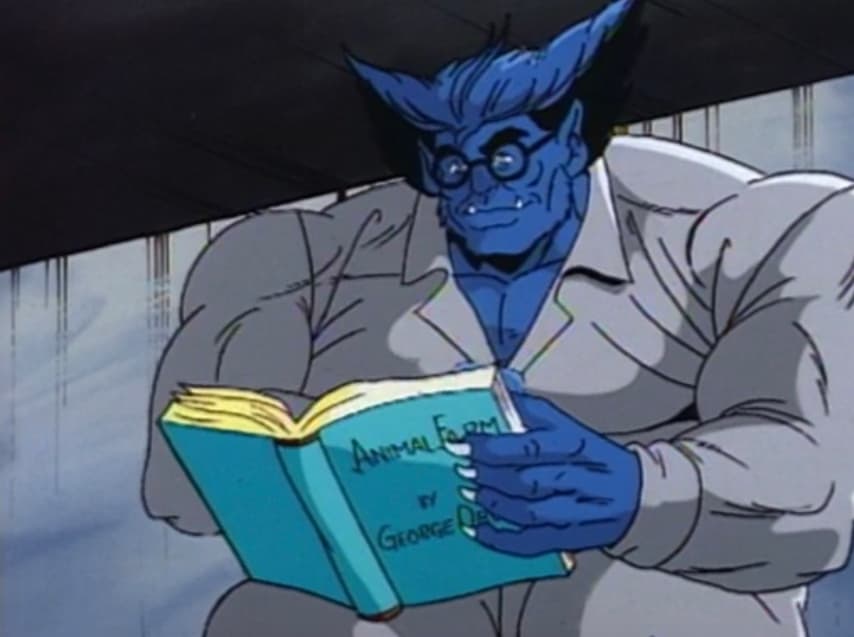
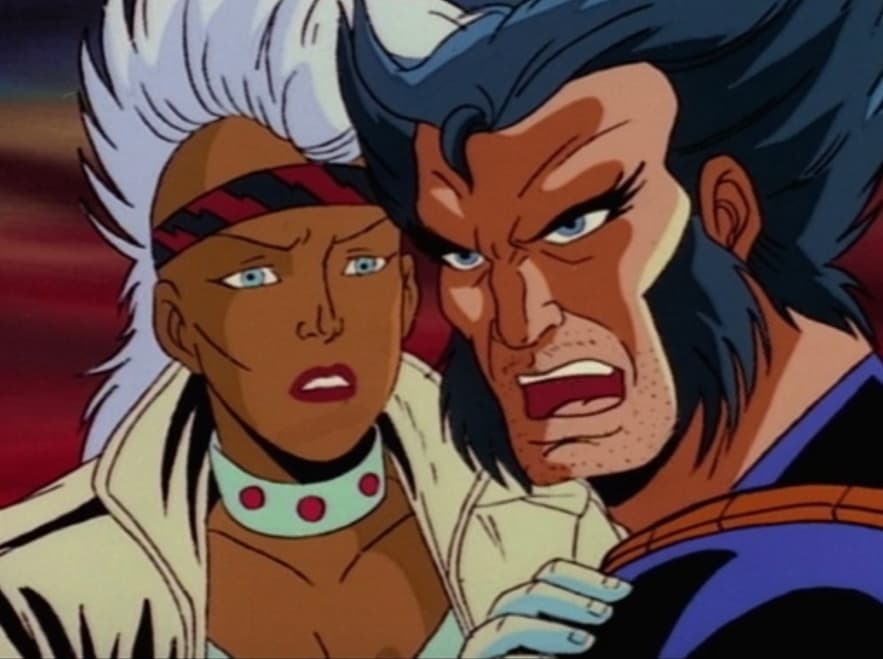
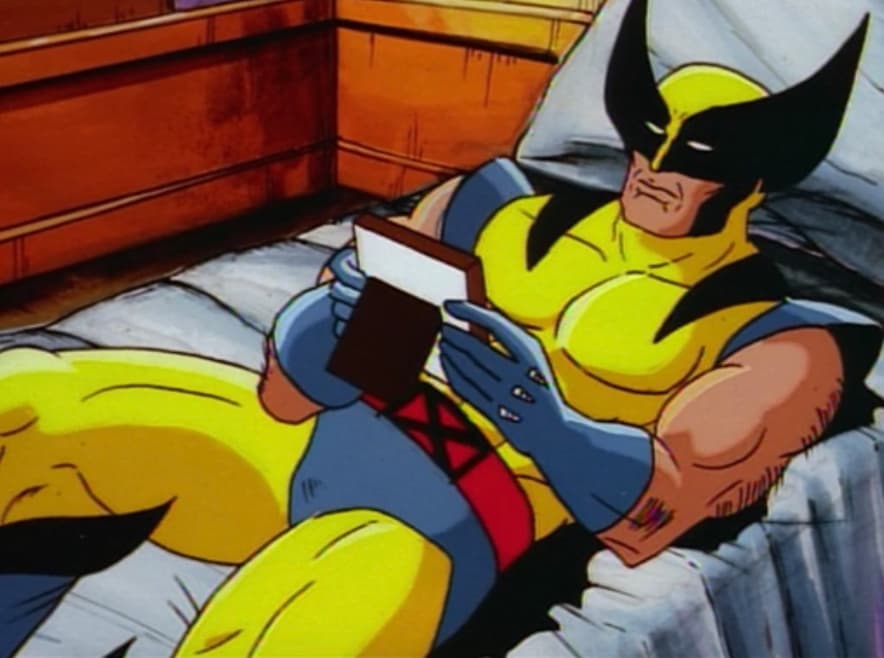
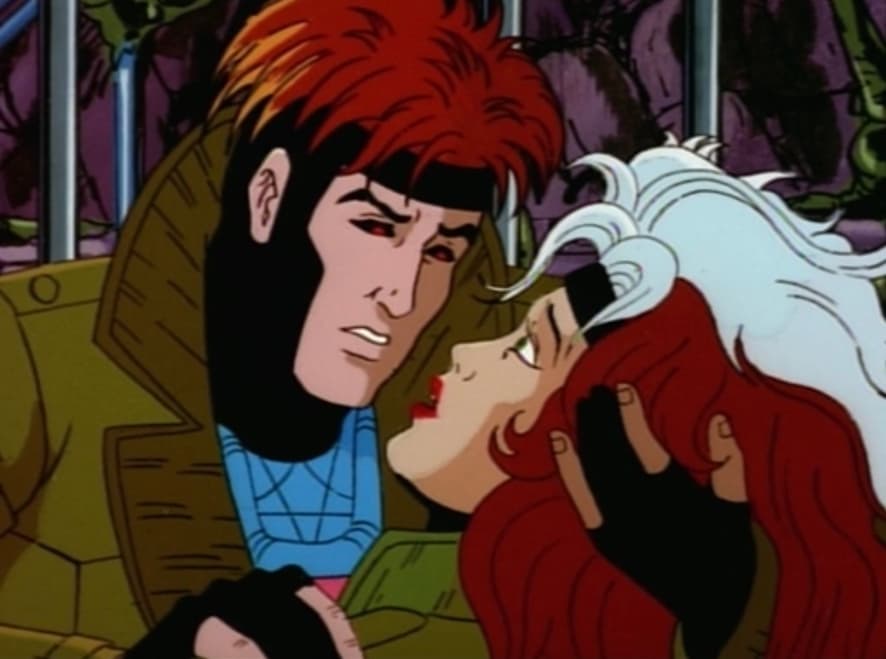
0 Response to "Where Can I Watch Xmen the Animated Series"
Post a Comment